Bali Chronicles #004: February 2024, Dharma Reigns Supreme
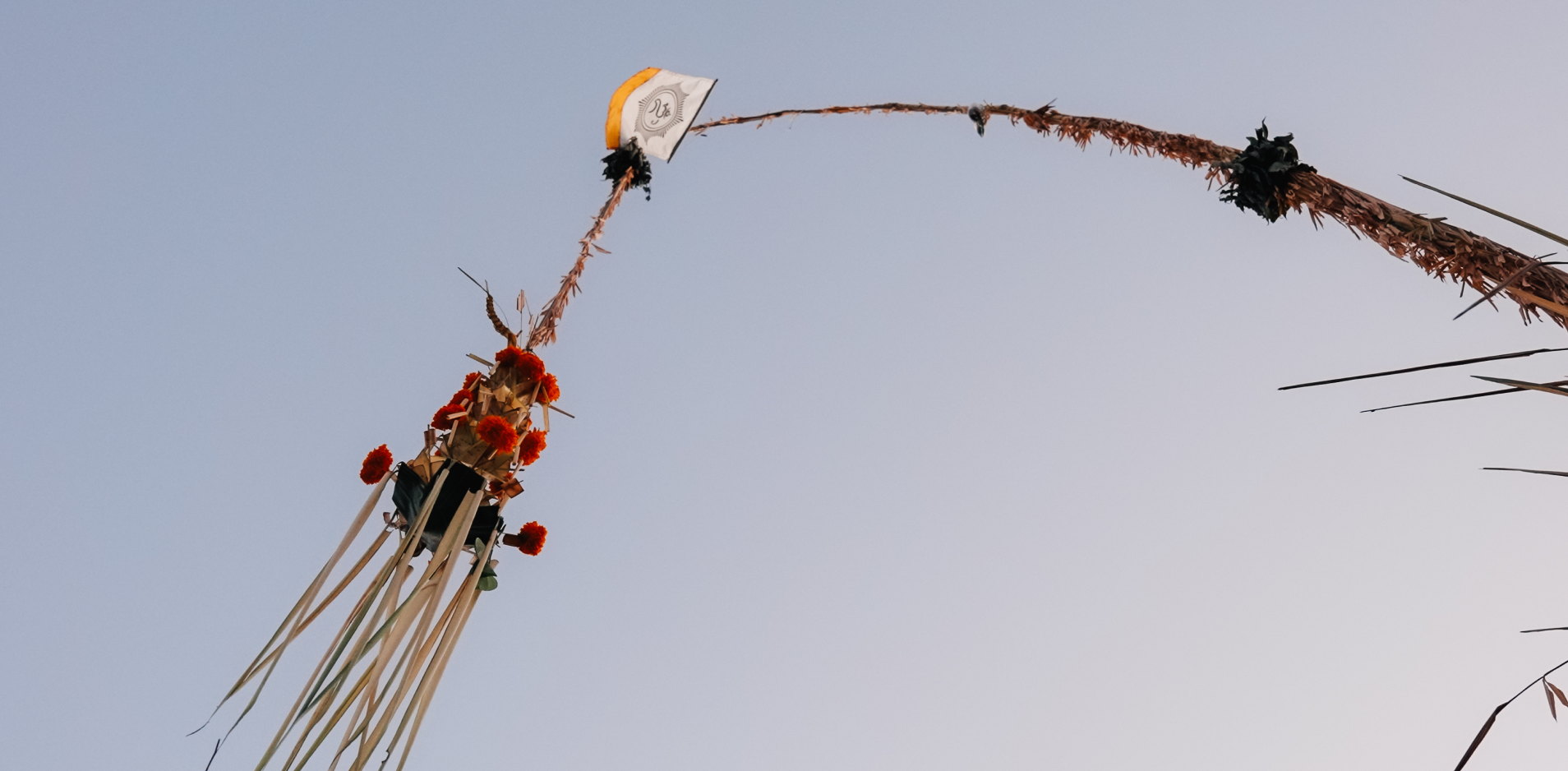
In Bali, where age-old legacies and modern elements intertwine dynamically, February 2024 emerges as a month of paramount significance because, throughout the island—from the lively beaches to the solemn peaks—will be enlivened with auspicious celebrations.
The arrival of several holy days leading up to the famous festival of ‘Galungan’, makes this month especially busy. Galungan, occurring every 210 days, stands as a spiritual zenith in the Balinese calendar. It’s a time of great joy for the islanders because it represents the spiritual triumph of virtue over vice, which is central to Balinese Hindu beliefs.
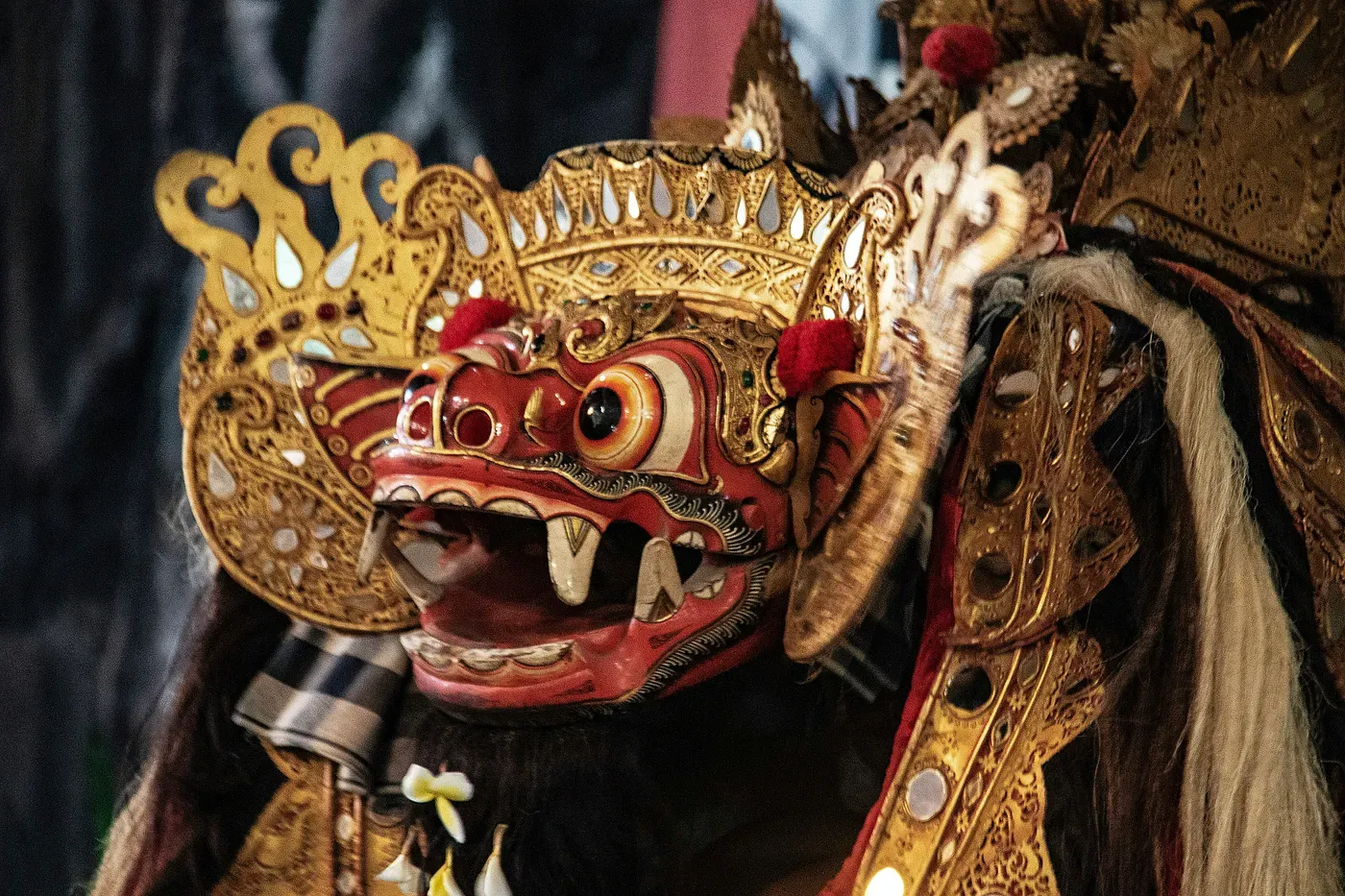
The festivity of Galungan and its associated celebrations in Bali present a fascinating outlook on Bali, vividly brought to life through a myriad of religious rituals revered for their spiritual significance and communal joy.
As the island buzzes with energy and fervor, the Balinese navigate through a packed schedule of auspicious days, each bringing its own unique significance and rituals, This includes:
- Saturday, February 3, 2024 (Saniscara Kliwon Wariga): Tumpek Wariga, a day honoring nature and the environment.
- Monday, February 5, 2024 (Soma Paing Warigadean): Soma Paing Warigadean, a period marked for introspection and spiritual growth, is dedicated to offering prayers to Brahma, venerating him as the deity of creativity and enlightenment.
- Wednesday, February 7, 2024 (Buda Wage Warigadean): Buda Wage Warigadean, another significant day to perform pujawali (temple festivals).
- Thursday, February 8, 2024 (Wraspati Kliwon Warigadean): Kajeng Kliwon Uwudan. Kajeng Kliwon, observed every 15 days, is dedicated to respecting and harmonizing human interactions with the world of the bhutas (spirits or supernatural beings).
- Friday, February 9, 2024 (Sukra Umanis Warigadean): Day of Bhatara Sri, a celebration honoring the rice goddess and the abundance she bestows, alongside tilem, marking the dark moon. This lunar phase embodies the concept that darkness is not to be feared but embraced, inviting an exploration of its depths, a merging with its essence, and an integration of it into our very selves.
- Tuesday, February 13, 2024 (Anggara Kasih Julungwangi): Anggara Kasih Julungwangi, a day dedicated to deep contemplation and the concentration of frequencies, vibrations, and spiritual energies towards Sang Hyang Ludra in his practice of yoga, with the purpose of purifying the world of its impurities.
- Thursday, February 22, 2024 (Wraspati Wage Sungsang): Sugian Jawa, which marks the start of the Galungan festival.
- Friday, February 23, 2024 (Sukra Kliwon Sungsang): Sugian Bali and Kajeng Keliwon Enyitan, continuing the Galungan preparations.
- Saturday, February 24, 2024 (Saniscara Umanis Sungsang): Purnama Kesanga, the full moon, a peak of spiritual activity.
- Sunday, February 25, 2024 (Redite Paing Dungulan): Penyekeban Galungan, commemorating the day for spiritual strengthening against Sang Kala Tiga.
- Monday, February 26, 2024 (Soma Pon Dungulan): Penyajaan Galungan, a day of further preparation.
- Tuesday, February 27, 2024 (Anggara Wage Dungulan): Penampahan Galungan, the eve of the Galungan festival.
- Wednesday, February 28, 2024 (Buda Kliwon Dungulan): Galungan, celebrating the triumph of good over evil.
- Thursday, February 29, 2024 (Wraspati Umanis Dungulan): Manis Galungan, a day of leisure as well as visiting family and friends.
Here is an overview of significant dates that showcase how the Balinese navigate and find meaning in each unique occasion, amidst the dynamic interplay of tradition and modernity:
Saturday, February 3, 2024 — Tumpek Wariga
Marking the approach of Galungan, the celebration of Tumpek Wariga holds great significance. This deeply respected Balinese ceremony is devoted to blessing plantations and gardens throughout Bali. The ritual symbolizes a profound appreciation for Mother Earth for endowing the land with fertility, promoting the healthy development of plants, and providing a bountiful yield of flowers, fruits, and oxygen.
Tumpek Wariga serves as a striking reminder, as it is the only major ritual observed island-wide before Galungan. Consulting the Balinese Pawukon Calendar reveals that Tumpek Wariga, falling in the week of Wariga, is just 25 days before Galungan, which occurs in the week of Dungulan.
Fun Fact #1: In the traditional Balinese Pawukon calendar system, there are 30 wuku — distinct periods that define the cycle of time. These are namely Sinta, Landep, Ukir, Kulantir, Tolu, Gumbreg, Wariga, Warigadean, Julungwangi, Sungsang, Dungulan, Kuningan, Langkir, Medangsia, Pujut, Pahang, Krulut, Mrakih, Tambir, Madangkungan, Matal, Uye, Manail, Perangbakat, Bala, Ugu, Wayang, Klawu, Dukut, and Watugunung. Each wuku, lasting seven days, is associated with its own set of cultural and agricultural events, rituals, and celebrations in Bali.
The proximity of Tumpek Wariga to Galungan sets in motion a period of careful planning and resource allocation among the Balinese. As Galungan draws near, families start to budget and save, preparing for the diverse array of activities, rituals, and celebrations that mark this important festival.
Moreover, the spirit of Galungan begins to permeate the island as Sugian Jawa approaches. In the days leading up to Sugian Jawa, a noticeable increase in traffic can be observed, a testament to the bustling activity in the markets. Here, people gather in large numbers to purchase essential items for the celebrations, including flowers, fruits, rice cakes, busung (young coconut leaves), arak and berem (traditional Balinese whiskey and wine), incense, wastra (decorative cloth), and bamboo poles — all vital components for the ceremonial offerings.
Fun Fact #2: Employers in Bali often disburse half of the Tunjangan Hari Raya (THR), or Religious Holiday Allowance, a customary financial bonus given to employees in anticipation of major religious holidays. Considering that Galungan can occur twice a year, employers often opt to either distribute half of the THR during each Galungan or choose to pay the entire amount during Nyepi, the Balinese Saka New Year. A number of companies and educational institutions have extended their generosity by providing practical essentials like poultry, rice, and cooking oil to their employees, ensuring that the spirit of the festival is celebrated not just in spirit but also through shared sustenance, nurturing both the body and the communal bond.
Thursday-Friday, February 22–23, 2024 — Sugian Jawa and Sugian Bali
Sugian are preparatory days leading up to the Balinese festival of Galungan. The word originates from Old Javanese, comprising the syllables ‘sugi’, ‘ya’, and ‘an’. ‘Sugi’ signifies purity or cleanliness, and ‘ya’ denotes existence or occurrence. The addition of the suffix ‘-an’ morphs the term into 'sugian’ in the Balinese Kapara (Common) language, encapsulating the meaning “to be sanctified or purified.”
First, Jawa, stems from Jambudwipa which, based on ancient Indian texts, can simply be interpreted as the entire human world. Additionally, there is a common belief that Jawa also refers to ‘jaba’ meaning the outer or external world.
Meanwhile, Bali, stems from ‘wali’ meaning sacred devotion to oneself, which refers to the inner world — the spiritual, mental, and emotional aspects of life.
This defies the notion that only those who are Jawa (descended from the Majapahit Kingdom) can celebrate Sugian Jawa and that only Bali Mula, or island natives, can celebrate Sugian Bali.
Fun Fact #3: I still remember my grandparents would simply interpret Jawa (Java) primarily as regions beyond Bali, a perception shaped by the more confined geographical awareness of their era. Despite pursuing my studies in Perth, Western Australia, my grandmother amusingly referred to my location as ‘Java’ whenever someone inquired about me.
Sugihan Jawa is about the purification of the external environment — the physical world around us. This includes the purification of homes, temples, and the natural environment, aligning with the belief that external cleanliness and order are essential for harmony and spiritual well-being. In terms of a Balinese traditional home, with its separate compounds, the spatial purification is all areas outside the mrajan or house temple
In contrast, Sugian Bali focuses on internal cleansing and purification, aiming to purify thoughts, emotions, and the spirit. It’s a time for introspection and spiritual alignment, ensuring that one’s inner self is prepared and cleansed for the upcoming sacred days. It’s about preparing the spiritual aspect of one’s being for the sacred celebration of Galungan.
These rituals reflect the Balinese Hindu philosophy of Tri Hita Karana, which emphasizes the balance and harmony between the human and spiritual realms (parhyangan), the human and human realm (pawongan), and the human and natural realm (palemahan).
By observing both Sugian Jawa and Sugian Bali, the Balinese seek to achieve a holistic balance between their internal spiritual state and their external physical environment, setting the stage for the sacred celebration of Galungan.
Fun Fact #4: Interestingly, there’s an additional, lesser-known Sugian called Sugian Tenten, which takes place just a day before Sugian Jawa, falling on February 21, 2024, in this instance. The term ‘tenten’ is derived from ‘enten’, meaning ‘to be awake’ or ‘vigilant’. This serves as a timely reminder to Balinese Hindus that Galungan is fast approaching. However, due to the absence of specific ceremonies associated with Sugian Tenten, its observance has diminished over time and is no longer widely practiced across the island. In a more worldly context, Sugian Tenten is a period when people throng to markets, as ‘tenten’ also connotes a temporary market.
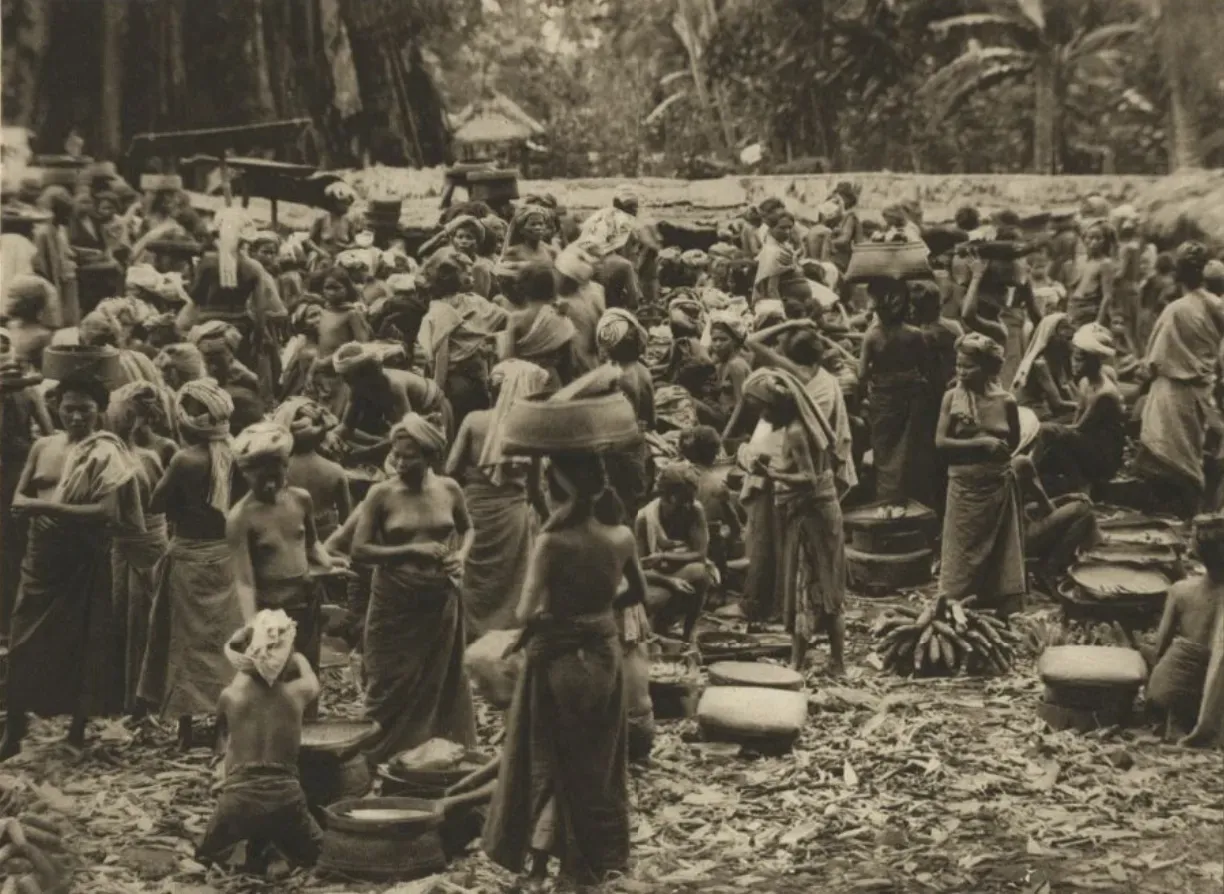
Sunday, February 25, 2024 — Penyekeban Galungan
Penyekeban Galungan represents a pivotal moment in the spiritual journey of the Balinese Hindu community towards embracing and realizing dharma.
Penyekeban, derived from the word ‘sekeb’, encapsulates the essence of ‘to confine’ or, more expansively, ‘to practice self-restraint’. Hindu scriptures emphasize this day as a crucial time for Hindus to engage in spiritual practices such as tapa (austerity), brata (vow), yoga (physical postures and breathing exercises), and samadhi (meditation), as elements of asuci laksana (purifying conduct).
Such emphasis is rooted in the belief that Penyekeban Galungan marks the descent of Sang Kala Tiga into the world, divine demonic-entities that disturb and test the faith of humans, particularly Balinese Hindus.
The Sang Kala Tiga, a powerful trio of forces, manifests distinctly as Sang Kala Galungan, Sang Kala Dungulan, and Sang Kala Amangkurat, each bringing their own brand of malevolent temptation. Each of these forces interacts with the human spirit in a play of temptation and influence, touching the mind, speech, and behavior in bad ways.
On the day of Panyekeban Galungan, Sang Kala Galungan makes its presence known, armed with sly deceptions. It seeks to cloud judgment and distort reasoning, casting a veil of confusion over thoughts. This force intricately weaves a web designed to mislead the mind, using its cunning tricks to lure one into a false sense of self-righteousness, subtly skewing perceptions, and leading towards overconfidence and complacency.
In times past, Penyekeban Galungan was a day when Balinese women traditionally engaged in picking or storing fruits, ensuring they ripened perfectly for Galungan three days later. Similarly, house mothers would gather at a single household to begin the preparation of offerings. This involved mejejahitan, a delicate process of leaf threading, where young coconut leaves were intricately assembled and fastened using semat or short wooden sticks, a task specific to the day of Penyekeban.
Penyekeban Galungan is also known as penapéan, a day when the Balinese partake in the art of fermentation, a crucial step in crafting tapé, a traditional and well-loved fermented delicacy. Made from rice, glutinous rice, or cassava, tapé stands out for its unique characteristics: a distinctive alcoholic scent, a flavor that balances sweet and sour, and a texture that is both soft and moist.
There’s a prevailing belief that the origin of tapé is linked to ‘tapa’, signifying a call for the Balinese to engage in ascetic meditation. This practice is seen as a means to counterbalance the malevolent influences of Sang Kala Galungan.
Fun Fact #5: Accompanying tapé is the delightful jaja uli, a chewy and dense snack rich in flavor, crafted from glutinous rice and rice flour. Beyond its plain variety, the sweet brown jaja uli is a must-try. Its inviting golden brown hue is derived from the addition of palm sugar, an all-natural sweetener produced from the sap of palm trees, including coconut, palm, and palmyra palm, lending a unique sweetness to this cherished treat.
During Penyekeban Galungan, while there may not be any specific ceremonial activities, the regular practice of yadnya in terms of daily prayers continues as usual.
Monday, February 26, 2024 — Penyajaan Galungan
Penyajaan Galungan is a significant preparatory phase for the Galungan festival in Bali, where the focus is on making traditional Balinese pastries. These are not only for consumption but also form a crucial part of the offerings.
Symbolically, this period represents the effort to resist the temptations of Sang Kala TIga, personified by Sang Kala Dungulan, by fostering mental serenity. The term penyajaan is derived from ‘saja’, signifying the ability to surmount these spiritual challenges.
The Sundarigama manuscript, in the context of Penyajaan Galungan, sheds light on the role of yoga as a means of personal communion between an individual and Brahman, the Mighty Creator, as well as with one’s own soul (Atman). This inner dialogue, essential in daily life, involves listening to the “soothing whispers of the heart.”
The manuscript underscores the gradual cultivation of the heart’s sincerity as a parallel to spiritual evolution. Achieving sincerity is a challenging yet vital part of spiritual success, often hindered more by internal struggles than external factors. Ultimately, the true measure of successful penyajaan lies in demonstrating sincere behavior in daily life, holding steadfast convictions, and consistently upholding Dharma.
This is important, as on Penyajaan Galungan, comes Sang Kala Dungulan, with its dark influence over speech. This malevolent force subtly invades human expression, enticing individuals to flaunt their strength, abilities, wealth, and pride. The corrupting power of Sang Kala Dungulan specifically targets the spoken word. It insidiously prompts people to engage in harsh and hurtful speech, weaving a destructive web of words that encourages conflict and pain among one another.
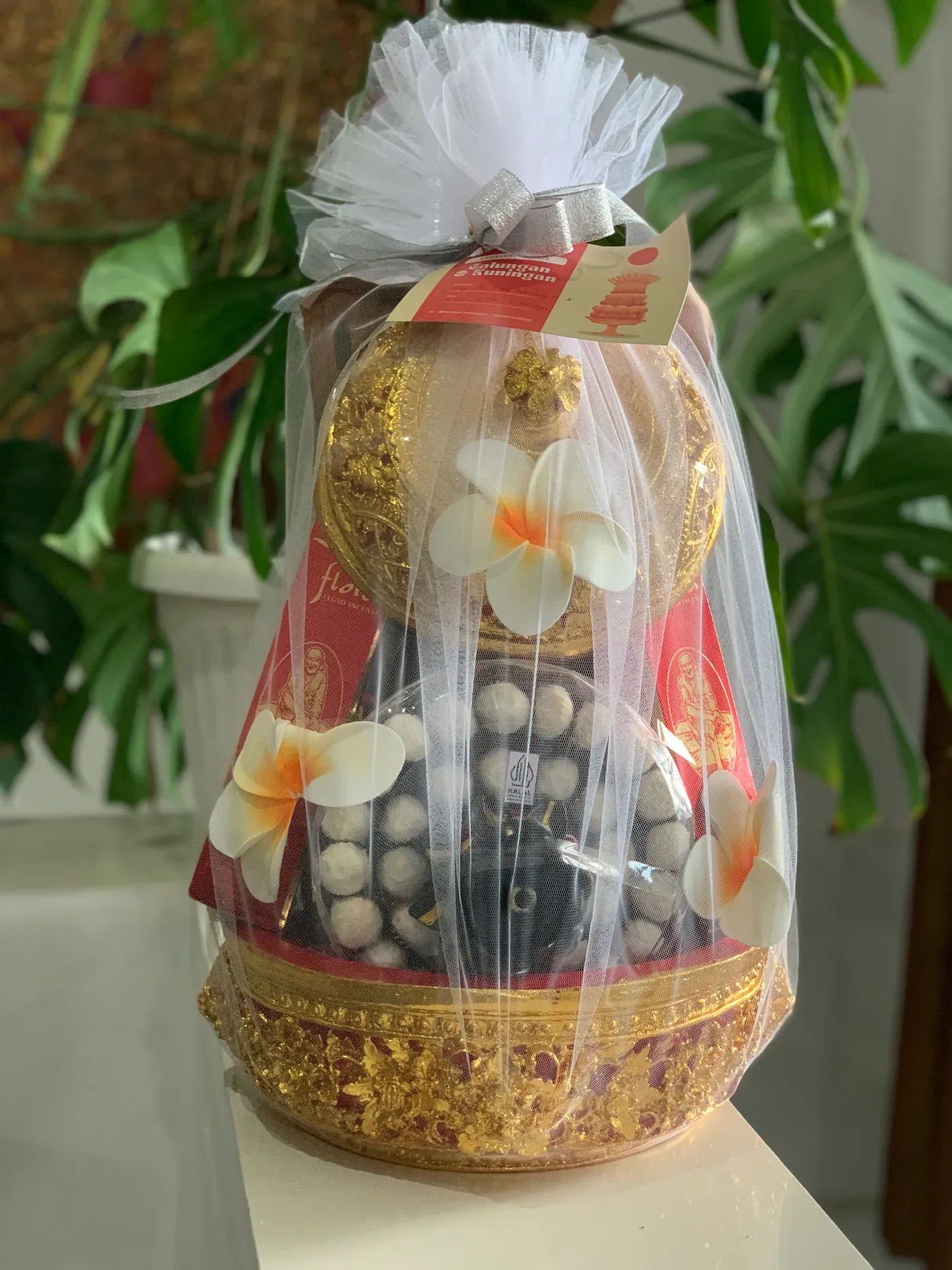
Fun Fact #6: Galungan and community gatherings are identic with ‘mejotan’ — a custom involving sharing and sending prepared meat and vegetable dishes among family and friends, symbolizing prosperity and social bonding. Mejotan, however, has changed as a result of evolving lifestyles. Nowadays, it’s common to exchange modern treats like chocolates, biscuits, and chips, blending traditional Balinese values of sharing and community with contemporary, global tastes.
Tuesday, February 27, 2024 — Penampahan Galungan
In contrast to the solemn rituals of Galungan, Penampahan, the day before Galungan, can be seen as a more celebratory event, especially as it encompasses a day of communal feasting.
The term ‘penampahan’ originates from ‘nampah’ meaning slaughter, which, before adopting the Balinese dialect, evolved from ‘nampa’, meaning offering, which in turn comes from ‘namya’ or ‘somya’, meaning worship and returning to the source.
During the day, Balinese men and youngsters come together, convening at dawn for a session known as mebat, involving the communal activities of chopping, cutting, mixing, and cooking meat for urutan (traditional sausage), komoh (broth), satay, tum (grinded meat and chopped skin, often containing animal blood, wrapped in a banana leaf, then steamed), and lawar (mixed minced meat and vegetables). Arak and beer are also served.
At times, the atmosphere can be rowdy, as the community engages in these preparations, marking Penampahan as a day of lively anticipation and communal bonding ahead of the sacred Galungan.
Penampahan Galungan is also a day of vigilance, as it’s the last chance for Sang Kala Tiga, in the form of Sang Kala Amangkurat, to tempt humans. It’s a time to avoid conflicts and resist temptations.
As Penampahan Galungan unfolds, Sang Kala Amangkurat exerts its subtle yet powerful influence, shaping actions with an unseen but deeply felt presence. Sang Kala Amangkurat tempts human behavior towards wrongdoing. Its nature is always desirous of control, over both the greater world (bhuwana agung) and the inner self (bhuwana alit). It tempts humans towards laziness, greed, and deceit. In this shadowy play of temptation, Sang Kala Amangkurat orchestrates a silent but potent sway over actions, steering them away from virtue.
Fun Fact #7: The slaughter of pigs, a traditional Bali custom during Penampahan Galungan, represents the control of one’s own animalistic desires, particularly the tamas (greedy and lazy) qualities represented and in fact possessed by pigs. The tendencies of a pig to eat and sleep represent laziness, and it is these characteristics that must be vanquished.
After the feast, women and young girls use this day to prepare offerings for the next day, while in the evening, men and adolescents start installing the penjor and adorn shrines with decorative cloths.
Fun Fact #8: In Bali, a humorous spin on the government’s health slogan “Empat Sehat Lima Sempurna” (Four Healthy, Five Perfect) reflects the local dietary habits. Traditionally, the Balinese daily diet consisted of rice, vegetables, and fruit, jokingly referred to as the “healthy three.” During temple festivals, meat is added to the menu, playfully upgrading it to the “healthy four.” They reach the “perfect five” only when they’re hospitalized , as that’s when they include milk, completing the government’s recommended food groups!
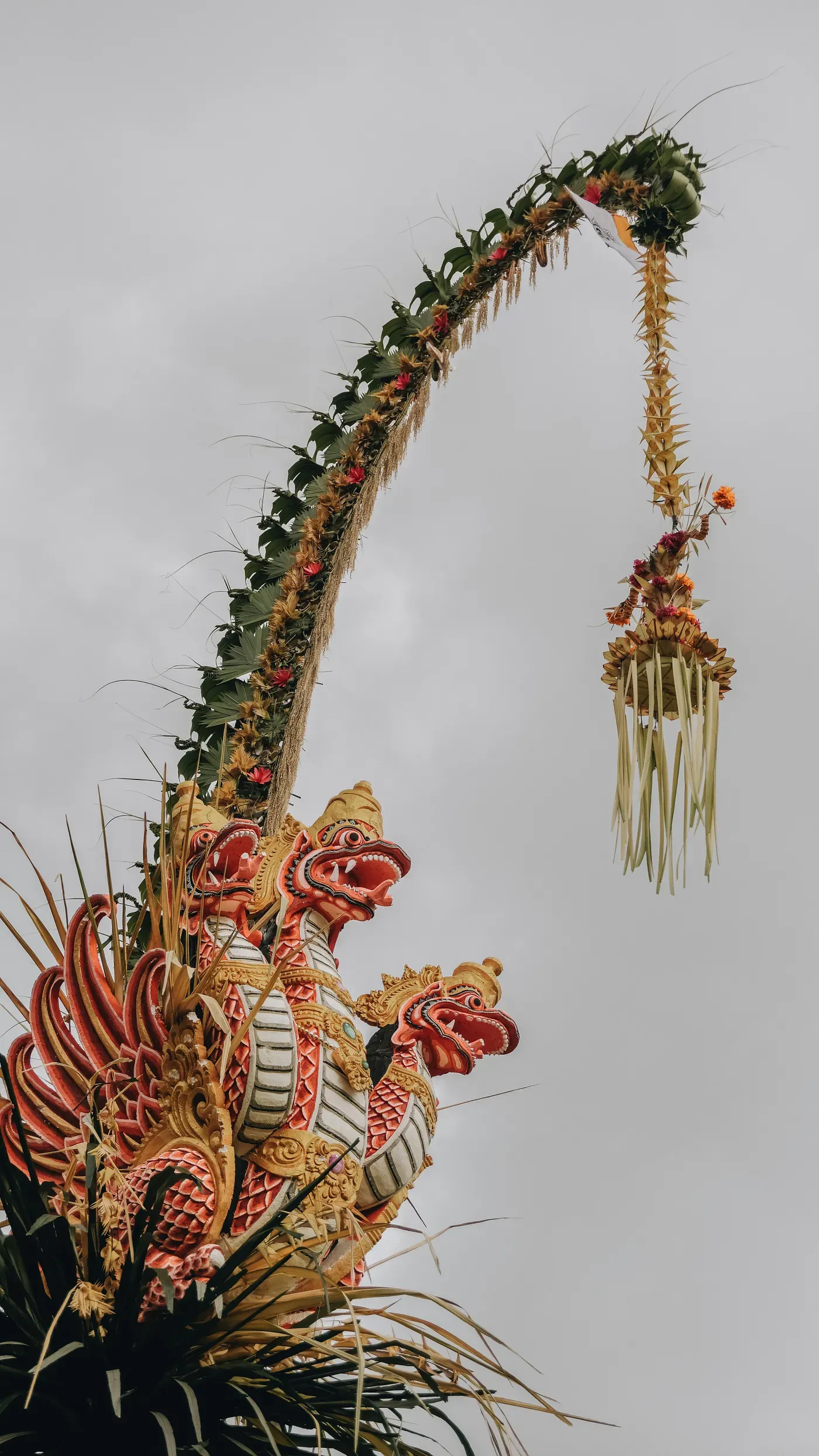
Fun Fact #9: One of the hallmarks of Galungan is the pénjor. These majestic bamboo poles adorned with busung, coconut, dried cakes, and fruits need to be set up by Tuesday afternoon, following tradition. The pénjor is a symbol of the divine dragon, Sang Hyang Naga Basuki, representing prosperity and abundance. It also symbolizes Mount Agung, considered sacred by the Hindu community in Bali. In mythology, Mount Agung is known as the abode or dwelling place of Sang Hyang Naga Basuki. The word 'Basuki' was later used to name Besakih.
Intricate guidelines dictate their creation: if Galungan aligns with purnama — the full moon, or Galungan Nadi, the bamboo poles are specially prepared with their lower skins cleanly shaved. Conversely, during the introspective new moon phase, known as tilem, the pénjors are not merely structural but also luminous, gracefully adorned with lights, adding a serene glow to the festive ambiance.
Wednesday, February 28, 2024 — Galungan
The atmosphere on Galungan Day is imbued with a sense of triumph, as the community commemorates dharma’s three-day struggle against adharma, from Sunday to Tuesday. Galungan, obligatory for all, is steeped in the profound belief of “rerahinan gumi” — a collective observance of faith and tradition.
Fun Fact #10: The Balinese adage, “Tusing ada Galungan Buwung!” (Galungan is never canceled!), was historically exemplified in 1955. During Indonesia’s inaugural General Election, the observance of the Galungan holidays led to a unique postponement of the voting process in Bali. Unlike other regions where elections proceeded on Thursday, 29th September 1955, in Bali, the coincidence with Manis Galungan necessitated a rescheduling. Consequently, the Balinese cast their votes two days later, on Saturday, 1st October 1955, showcasing the revered status of Galungan — a celebration so significant that not even a national election could supersede it. Source: “Pemilihan Umum dan Galungan di Bali” oleh R. Margo, KDPPR, Nusa Tenggara in Mimbar Penerangan VI No.1 January 1955.
The ancient Sundarigama text intertwines Javanese and Balinese linguistics, where ‘galungan’ resonates with ‘dungulan’, echoing themes of victory and supremacy. This festival is often brought to life through the legendary tale of Mayadanawa, elaborately detailed in the Usana Bali manuscript.
This story serves as a metaphorical canvas, depicting the eternal conflict between the righteous dharma, personified by the deity Indra, and the deceptive adharma, embodied by the disbelieving king Mayadanawa, who disbelieves in the existence of the Almighty Creator and the importance of religious ceremonies.
The day commences with devotional activities at the family's private temple. Members of the family dress in white and yellow, symbolizing purity and happiness. The breakfast spread is lavish, featuring an abundance of food, notably the surplus meats from the previous day's celebrations. The family engages in prayers both at their home temple and the community's central temple, continuing the day's spiritual observances.
As the day unfolds, the atmosphere is charged with a sense of togetherness and joy. The streets buzz with activity, reflecting the cheerful light of the sun. People of all ages, dressed in their ceremonial attire, gather in swarms towards the temples, their faces radiating happiness and their hearts filled with collective hope.
This communal journey to sacred places symbolizes the island’s resilient spirit. Every step taken in unison, every prayer shared, strengthens the community’s bond, reinforcing their belief in Bali as a haven of prosperity and safety.
During Galungan, across Bali, particularly at the Tirtha Empul Temple in Manukaya Village, surrounding communities gather to parade their pratimas, barongs, and rangdas, participating in the sacred ‘masucian’, a water blessing ceremony, a profound expression of spiritual cleansing and rejuvenation.
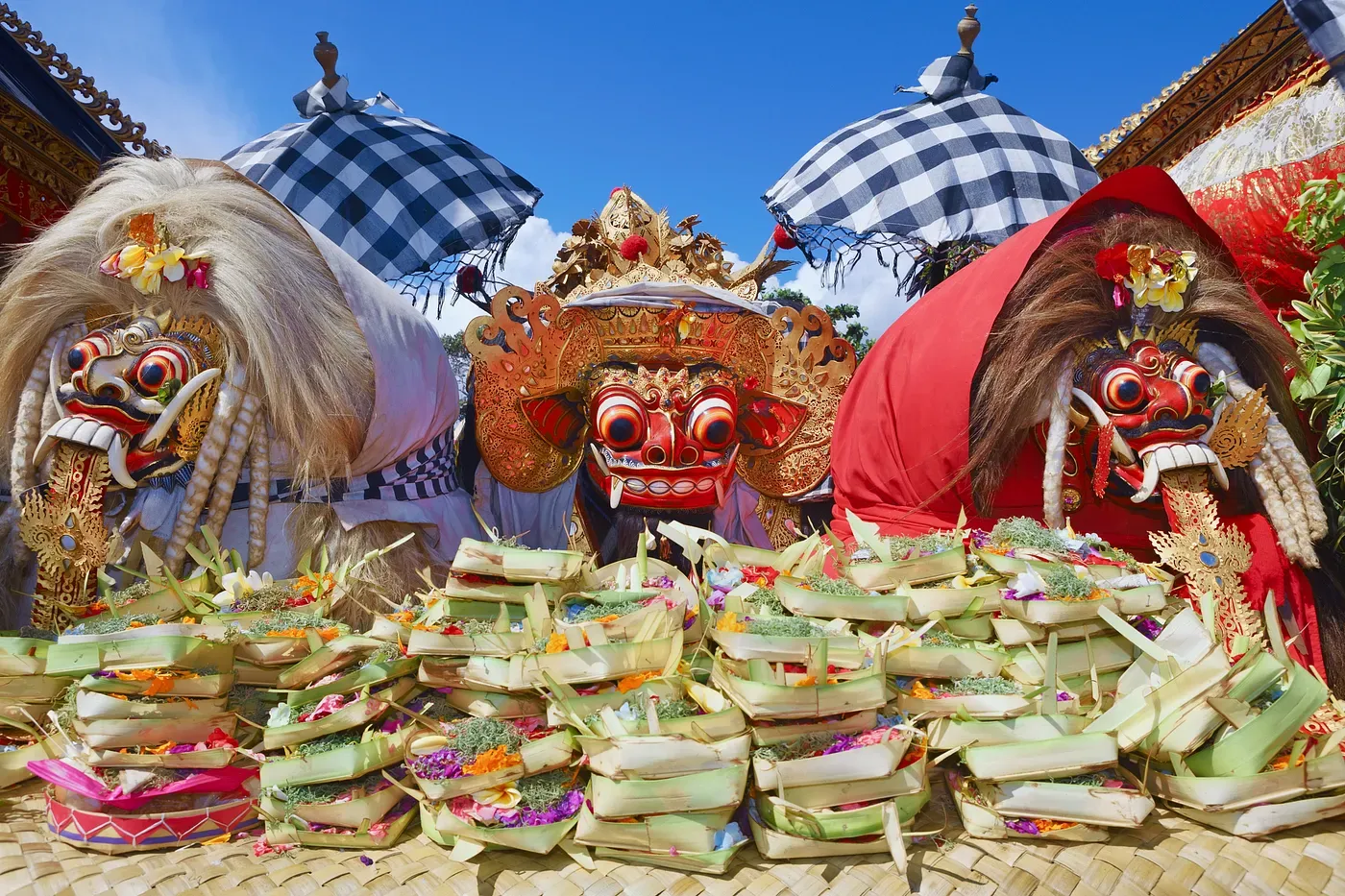
In these moments of shared celebration and devotion, every laugh and every greeting exchanged fortifies the island’s heritage, a heritage preserved through generations through rituals. In this blend of personal resilience and communal unity, the profound truth illuminates the path to their ultimate victory — dharma reigns supreme.
Thursday, February 29, 2024 — Manis Galungan
Manis Galungan, often mistakenly thought to mean ‘sweet’ due to the literal translation of manis, actually derives from ‘Umanis’. This term refers to a specific day in the five-day week cycle of the Pawukon calendar, rather than denoting sweetness.
On this occasion, Balinese Hindus partake in the natab sesayut or tebasan ceremony. Natab involves a repetitive gesture of moving both hands towards the body, specifically targeting the eyes, ears, mouth, and heart, as a means of embracing purifying energies during the ritual. Meanwhile, sesayut, which comes in various forms, consists of offerings made from daily produce like fruits and flowers. These offerings serve as a conduit for rejuvenating and sustaining the body’s positive energy, ensuring maintained energy levels and a positive outlook for everyday tasks.
After natab sesayut, it’s customary to visit relatives to strengthen family bonds or to take leisure trips to tourist spots with friends, family, and significant others. At its core, Umanis Galungan is all about contagious joy.
As Manis Galungan concludes, the pace of life in Bali momentarily pauses, offering a time for joy and reflection before transitioning into the preparations for Kuningan. This impending day of significance, set to arrive in ten days, offers another profound opportunity to honor the Almighty Creator and the universe, acknowledging the abundance of blessings received. Kuningan, akin to Galungan, symbolizes a period of exuberant celebration, melding seamlessly with the spiritual path of the Balinese Hindus.
During Manis Galungan, make the time to visit the orderly beauty and cultural heritage of Penglipuran Village in Bangli Regency, a UNWTO-awarded tourist village that exemplifies the perfect balance between community-based tourism and environmental sustainability.
Fun Fact #11: In the days following Galungan, Balinese families humorously refer to the routine of repurposing leftover festive dishes as “ulangan umum,” meaning ‘common repetition’. This term is gleefully used when frying or steaming leftover lawar into tum, turning it into a delightful routine. When asked about meals, they often quip, ‘ulangan umum’, a lighthearted nod to the enjoyable, repeated servings of ‘be celeng’ (pork).
. . .
To end, Pagerwesi, Galungan, Kuningan, and Nyepi are the four principal holy days in the Hindu Balinese calendar, each signifying a distinct blend of worldly festivities and spiritual upliftment. Far beyond mere social or religious gatherings, these festivals embody a deeper confluence, persistently reminding the Hindu Balinese of the vital interconnectedness of Tattwa, Susila, and Upakara.
These three core tenets of Hindu teachings — encompassing philosophy, morality, and ceremonial practices — are mutually reinforcing and essential to the Balinese way of life.
The recurring cycle of these holy days serves as a constant, not only maintaining a worldly connection with the celestial realms and heavens but also seeking to balance the unknown, the chaotic, and sometimes the feared aspects of the underworld, integrating them harmoniously into everyday existence.
Rahajeng lan rahayu Galungan, my dear sisters and brothers. Matur suksma — with heartfelt gratitude, we share our cultural heritage with you in its fullness.
Written by: Marlowe Bandem
Executive Director of Indonesia, Quantum Temple